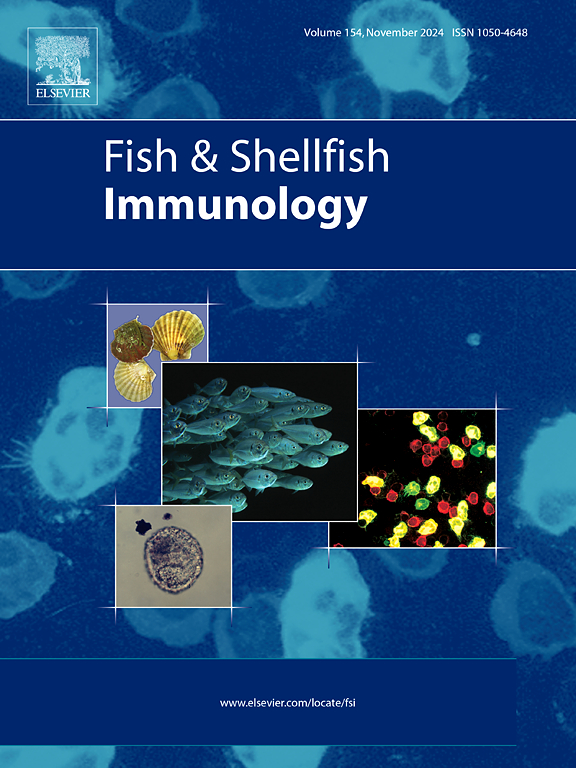Teleost HMGB1 paralogues mediate protective autophagy by interacting with NOD2 and ATG16L1 and activating ROS/Akt/mTOR pathway against Aeromonas hydrophila infection
IF 3.9
2区 农林科学
Q1 FISHERIES
引用次数: 0
Abstract
As a multifunctional regulator, high mobility group box 1 (HMGB1) plays an important role in DNA transcription, autophagy, infection and inflammation in mammals based on its cellular localization. Unlike in mammals, some teleost has two HMGB1 paralogues, and the DNA-binding and pro-inflammatory functions of extracellular HMGB1 have been characterized in various fish species, but the functional role of intracellular HMGB1 in bacterial infection remains elusive. In this study, the inducible effect of Aeromonas hydrophila (A. hydrophila) on autophagy was identified by using the autophagy related gene 7 (Atg7)-knockdown Epithelioma papulosum cyprini (EPC) cells, where fish HMGB1 paralogues have been defined as the autophagy regulator in our previous study. Consistently, the HMGB1 paralogues were proved to mediate A. hydrophila-induced autophagy by knockout HMGB1 paralogues and using HMGB1 inhibitors in the same cells, and suggested the defensive role of HMGB1 paralogues against A. hydrophila infection. Mechanistically, in accordance with the findings that nucleotide-binding oligomerization domain 2 (NOD2) but not NOD1 was involved in A. hydrophila-induced autophagy, HMGB1 mediated autophagy by interaction with NOD2 and ATG16L1. In addition, transcriptomic and western blotting assays further uncovered that HMGB1 regulated A. hydrophila-induced autophagy potentially by the ROS/AKT/mTOR signaling pathway. Furthermore, the physiological importance of HMGB1-mediated autophagic mechanism was strengthened in the primary neutrophils of grass carp, in which a complete autophagy flux mediated by HMGB1 facilitated A. hydrophila clearance. Notably, two HMGB1 paralogues played the same role in aforementioned events. Taken together, the intracellular role of fish HMGB1 paralogues in the autophagic response to A. hydrophila infection provided new insights into the immunological function of fish HMGB1, and offered clues as to how fish can defend themselves against bacterial infection.
硬骨鱼HMGB1副同源物通过与NOD2和ATG16L1相互作用,激活ROS/Akt/mTOR通路,介导保护性自噬,对抗嗜水气单胞菌感染。
HMGB1 (high mobility group box 1, high - mobility group box 1)是一种多功能调节因子,基于其细胞定位,在哺乳动物DNA转录、自噬、感染和炎症等方面发挥重要作用。与哺乳动物不同,一些硬骨鱼有两个HMGB1类似物,并且细胞外HMGB1的dna结合和促炎功能已经在各种鱼类中被表征,但细胞内HMGB1在细菌感染中的功能作用仍然是未知的。本研究通过自噬相关基因7 (Atg7)敲低cyprini上皮瘤丘疹细胞(epithelial oma papulosum cyprini, EPC),鉴定了嗜水气单胞菌(Aeromonas hydrophila)对自噬的诱导作用,其中鱼类HMGB1同源物在我们之前的研究中被定义为自噬调节因子。同样,通过敲除HMGB1旁拟物和在相同细胞中使用HMGB1抑制剂,证明了HMGB1旁拟物介导嗜水单胞菌诱导的自噬,并提示HMGB1旁拟物对嗜水单胞菌感染具有防御作用。从机制上看,根据嗜水螅诱导的自噬过程中核苷酸结合寡聚化结构域2 (NOD2)而非NOD1参与的研究结果,HMGB1通过与NOD2和ATG16L1相互作用介导自噬。此外,转录组学和western blotting分析进一步发现,HMGB1可能通过ROS/AKT/mTOR信号通路调节嗜水草诱导的自噬。此外,HMGB1介导的自噬机制在草鱼初级中性粒细胞中的生理重要性得到了加强,HMGB1介导的完全自噬通量促进了嗜水假单胞菌的清除。值得注意的是,两个HMGB1平行体在上述事件中发挥了相同的作用。综上所述,鱼类HMGB1同源物在嗜水螅感染自噬反应中的细胞内作用为鱼类HMGB1的免疫功能提供了新的见解,并为鱼类如何保护自己免受细菌感染提供了线索。
本文章由计算机程序翻译,如有差异,请以英文原文为准。
求助全文
约1分钟内获得全文
求助全文
来源期刊

Fish & shellfish immunology
农林科学-海洋与淡水生物学
CiteScore
7.50
自引率
19.10%
发文量
750
审稿时长
68 days
期刊介绍:
Fish and Shellfish Immunology rapidly publishes high-quality, peer-refereed contributions in the expanding fields of fish and shellfish immunology. It presents studies on the basic mechanisms of both the specific and non-specific defense systems, the cells, tissues, and humoral factors involved, their dependence on environmental and intrinsic factors, response to pathogens, response to vaccination, and applied studies on the development of specific vaccines for use in the aquaculture industry.
 求助内容:
求助内容: 应助结果提醒方式:
应助结果提醒方式:


